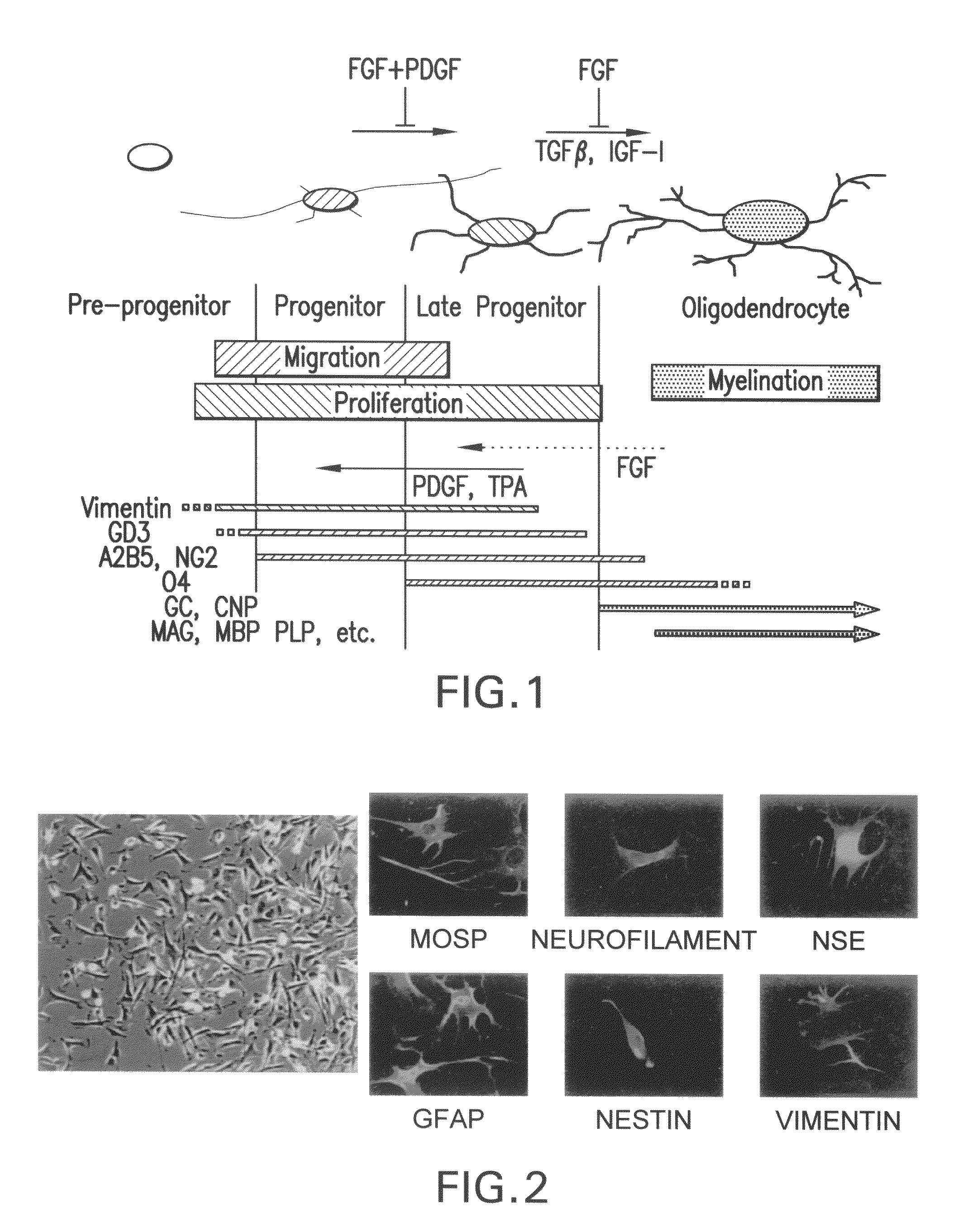Production of oligodendrocytes from placenta-derived stem cells
a technology of placenta and oligodendrocytes, which is applied in the direction of biocide, artificial cell constructs, drug compositions, etc., can solve the problems of difficult acquisition of stem cells and ethical concerns that cannot be easily addressed
- Summary
- Abstract
- Description
- Claims
- Application Information
AI Technical Summary
Problems solved by technology
Method used
Image
Examples
example 1
6.1 Example 1
Oligodendrocyte Maintenance Medium
[0204]A representative medium for maintaining oligodendrocytes is as follows. Preferred medium is a serum-free formulation optimized for the maintenance of rodent OL lineage cells. A base media (R1236) comprises DMEM high glucose supplemented with (Sigma), 1 mM Na pyruvate, antibiotics (penicillin-streptomycin), 0.05 μg / mL insulin (to stimulate the glucose transporter), 100 μg / mL transferrin (iron uptake), 30 nM selenium (metabolic cofactor), 10 μM forskolin (cAMP), 60 μg / mL N-acetyl cystein (Redox, survival), and 5 μg / mL bovine serum albumin (carrier protein). Rodent oligodendrocyte progenitor cells are maintained using R1236 supplemented with mitogens to promote proliferation and self renewal (10 ng / mL PDGF-AA plus 5 ng / mL FGF2, or 20% v:v B104 conditioned media). To promote oligodendrocyte differentiation mitogen-containing medium is replaced with R1236 containing 10 μg / mL bovine insulin plus 5 μg / mL T3 (triiodothreonine), both of wh...
example 2
6.2 Example 2
Obtaining Stem Cells from Placenta by Enzymatic Digestion
[0205]An exemplary protocol for obtaining stem cells from placental tissue by enzymatic digestion is as follows. Frozen placental tissue (three pieces of approximately ˜1×1×0.5 cm each) is obtained. The tissue is umbilical cord, maternal surface of the placenta, or amniotic membrane. Digestive enzymes used include trypsin-EDTA (0.25%, GIBCO BRL); collagenase IA (Sigma), collagenase I (Worthington), collagenase 1A (Sigma)+Trypsin-EDTA, collagenase 1 (Worthington)+Trypsin-EDTA, or Elastase+Collagenase I+Collagenase IV+Daspase (Worthington). Digestion of placental tissue is as follows. Tissue is minced in the presence of enzymes (1 g in 10 ml in 50 ml tube) at 37° C., 250 rpm shaking, tube position at 45° angle for 1 hr (C25 Incubator Shaker, New Brunswick Scientific, Edison, N.J., USA). The supernatant is then discarded. The pellet is washed with 20 ml Hank's+5% FCS (3 times), and re-suspended in 12 ml culture mediu...
example 3
6.3 Example 3
Oligodendrocyte Progenitor Lineage Assays
[0206]The emergence, maturation and differentiation of OPCs can be determined by immunochemistry and transcript expression. For immunochemistry, cells growing on glass coverslips are incubated in culture media containing specific concentrations of growth factors. Coverslips removed after 1-7 days are fixed with 4% para-formaldehyde then characterized using lineage-specific antibodies (Table 1). Staining is detected using secondary antibodies coupled to fluorescent tags (Alexa Fluors, Molecular Probes Inc) and visualized by fluorescence microscopy. Secondary antibodies alone are used as a negative control. The proportion of cells that are immuno-reactive will be determined by counting up to 200 cells per coverslip.
[0207]
TABLE 1Immunohistochemical reagents:Stage; AntibodySpecificityTargetSourceReferencenSC:NestinMs IgGfilamentDSHB(Johe et al., 1996)NRP:e-NCAMMs IgGfilamentDSHBGRP:A2B5Ms IgMgangliosidescond. media (ATCC)(Eisenbarth ...
PUM
| Property | Measurement | Unit |
|---|---|---|
| doubling time | aaaaa | aaaaa |
| molecular weight | aaaaa | aaaaa |
| temperature | aaaaa | aaaaa |
Abstract
Description
Claims
Application Information
 Login to View More
Login to View More - R&D
- Intellectual Property
- Life Sciences
- Materials
- Tech Scout
- Unparalleled Data Quality
- Higher Quality Content
- 60% Fewer Hallucinations
Browse by: Latest US Patents, China's latest patents, Technical Efficacy Thesaurus, Application Domain, Technology Topic, Popular Technical Reports.
© 2025 PatSnap. All rights reserved.Legal|Privacy policy|Modern Slavery Act Transparency Statement|Sitemap|About US| Contact US: help@patsnap.com

